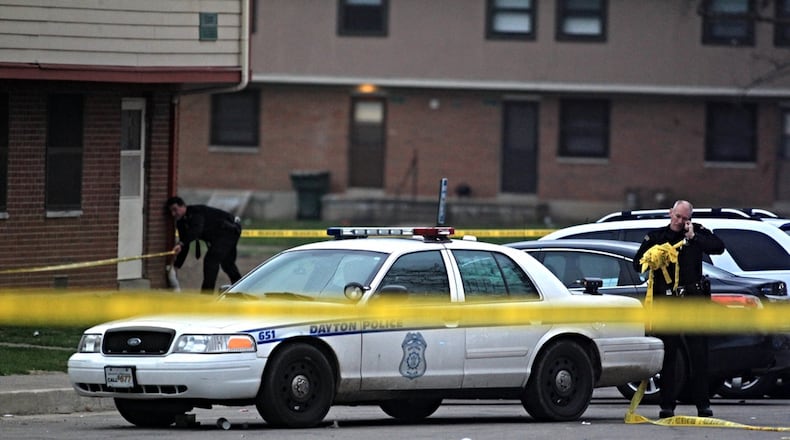»RELATED: Violent Dayton gun crimes prompt police changes
Dayton police plan to use a “place-based” investigation strategy to try to reduce gun violence and combat crime in some of these tiny pockets of trouble.
The strategy focuses on persistent, chronic “micro areas” of violence that calls for police to work with other city departments, property owners, businesses and community groups to dismantle the infrastructures that support criminals and violent activity, said Tamara Madensen, associate professor of criminal justice and graduate director at the University of Nevada, Las Vegas.
The goal is to take down violent offenders and take away their spaces, officials said.
“This isn’t a police-driven approach,” said Madensen, who is consulting the Dayton Police Department. “This is a city-driven approach.”
Dayton officials hope the new policing approach can help reverse some worrisome trends. The city has seen an increase in gun crime and gun crime that causes injuries.
»RELATED: Gun crime up in Dayton
A few criminal offenders account for most of the crime in U.S. communities, according to researchers, and similarly, gun violence tends to be concentrated on specific streets, street corners and areas.
About 39 percent of shootings in Dayton last year took place in micro areas that put together represent less than 0.7 square mile of space, according to preliminary research by Madensen, Lt. Col. Maris Herold with the University of Cincinnati Police Department and Blake Christenson, senior crime analyst with the Cincinnati Police Department.
A disproportionate amount of crime is “concentrated in these tiny, tiny micro hot spots,” Madensen said. “These are chronic … these have been problem places for a very long time.”
Police officials declined to identify where the micro hot spots are, but this newspaper has made a records request to try to determine their locations.
»RELATED: Violent crime surround school where girl was stabbed
Deploying police resources to these areas can result in temporary reductions in crime, but achieving long-term, sustainable reductions usually proves elusive, Madensen said.
Dayton is not certainly unique, Madensen said, because concentrated violence is a common crime pattern in U.S. communities.
The traditional approach to violence reduction focuses almost solely on police action and arresting offenders, but arresting them does not prevent others from taking their place at the same locations, Madensen said.
The place-based investigation strategy has police identify high-crime micro areas but then also identify sites that support the criminal activities, such as where offenders hang out, meet and live, Madensen said.
If there is an open-air drug market where violence commonly occurs, police and other partners would identify and target nearby businesses, residences, public spaces and parking lots that provide drug dealers and offenders comfort spaces and spots to congregate and orchestrate their illegal dealings, said Lt. Col. Herold.
»RELATED: Dayton homicide rate climbs to 40 for the year
Of course, violent offenders must be arrested when they break the law, but police need to disrupt criminal networks by working closely with others on focused deterrents, Herold said.
In Cincinnati, a crime hot spot was cooled down when the city eliminated parking that was used for drug exchanges, tore down buildings where criminal activity occurred and added lighting to dark streets where dealers roamed, Herold said.
“You really have to disrupt these networks,” Herold said. “All in all, we worked with nine city departments on this project.”
The Dayton Police Department is planning to implement a place-based investigative strategy this year at sites not yet announced.
Dayton police Chief Richard Biehl said the approach has shown impressive results in Cincinnati and makes perfect sense to target the network of places that support criminal activity.
“That’s been the missing link,” he said.
Biehl said his department hopes to make a dent in addressing the growing issue of gun violence.
DOWNLOAD OUR MOBILE APPS FOR LATEST BREAKING NEWS
Rising levels of gun crimes prompted the Dayton Police Department earlier this year to reorganize to create a new Violent Crime Bureau, which has a special unit to focus on offenders who fuel gun violence and other gun and robbery offenses.
Last year, there were 535 firearm-related crimes in Dayton, which was up nearly 21 percent, according to police data.
Of those incidents, 111 gun crimes resulted in injuries, which was a small increase from 2015.
Biehl said the strategy likely does not require additional funding.
“We’re talking about taking existing city staff and police personnel and focus them collectively on very, very small geographic areas,” he said.
BY THE NUMBERS
Dayton’s violent hot spots are found in areas that combined are less than 0.7 square miles but account for:
39 percent of shootings
17 percent of firearm offenses
14 percent of robberies
7 percent of shots fired dispatch calls
SOURCE: Dayton Police Department
About the Author

